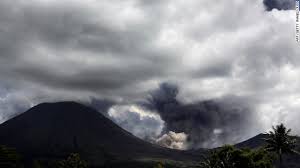
November 29, 2012 – INDONESIA – Mount Lokon volcano in North Sulawesi erupted on Wednesday, spewing ash up to 3.5 kilometers to the sky, without report of fatality and evacuation, officials said. Head of National Volcanology Surono said that the eruption took place at 10:05 local time (0205 GMT). He said that the agency had asked people living near the crater to be alert.
“We issued warning to the people living 2.5 kilometers from the crater,” Surono told Xinhua by phone. Spokesman of National Disaster Management and Mitigation Agency (BNPB) Sutopo Purwo Nugroho confirmed that there was no evacuation after the eruption. “There is still no need for evacuation,” he told Xinhua by phone. Indonesia, an archipelago country, is home to 129 active volcanoes. –Xinhua